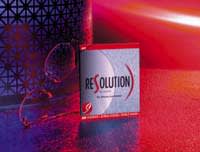SPECTACLE LENSES
Alternative Lens Material
New materials are bringing better optics
without losing their shatter resistance. This opens up a whole new world for
your customers
By Joseph L. Bruneni
The optical industry has seen an avalanche of new developments in ophthalmic lenses during the past 10 years�more than during the preceding 100 years. These improvements have ranged from lens designs to lens coatings. None, however, has had greater impact than the changes and improvements in lens materials.
|
|
|
|
A drop-ball test is performed on a lens made with Trivex, a new lens material from PPG Industries. |
|
If one were to choose the lens advancement making the greatest impact during the 20th century, it would have to be the introduction of plastic lenses following World War II. That transition from glass to CR 39� took the optical industry more than 20 years to accomplish.
For the last 30 years, the United States has been the only country that mandates eye protection for those who wear eyeglasses. This FDA requirement dates back to 1972 and mandates that glass lenses must pass minimum impact testing, using a test in which a steel ball is dropped onto the lens. If the lens does not break or splinter, it can be legally dispensed here. This federal requirement has profoundly affected choice of lens materials.
Early in the 1990s, other influences began to make an impact. They arose from a growing consumer desire for lighter, thinner lenses. New materials were developed (mostly plastic) with a higher refractive index than glass (1.52) or plastic (1.50). Originally lumped into the category of "high index," these lenses are now divided into two categories�mid index (1.53 to 1.58 index) and high index (1.59 and higher).
|
|
|
|
Lenses made from Trivex are impact-resistant. Photo courtesy of PPG Industries. |
Currently, the eyecare professions can choose from 11 indices in plastic and another five in glass. But thin edges hasn�t been the only issue. The development of polycarbonate in the 1980s introduced a new factor�safety.
Poly limped along for a few years as manufacturers and labs learned how to work with this soft material. In terms of production, poly lenses are injection molded, whereas other plastic lenses are cast�a simple process in which liquid plastic monomer is poured into a gap formed by two glass molds that are separated by a rubber-like gasket.
Injection molding was a totally different way of producing lenses, and it took time to learn how to produce quality lenses in this new way. Over time, the quality of poly improved, and as interest in high index lenses increased, it became a viable choice. When the OLA introduced the "duty to warn" program to protect eyecare professionals from liability issues, polycarbonate came of age.
A New Influence
As the 20th century drew to a close, a new influence began to manifest itself. In certain ways, a lens is a lens. As exemplified with poly, however, developing a better material provides a lens producer a way to distinguish its entire line, not just one lens design.
As a result, the desire to replicate poly�s success became a major challenge for lens producers. Here is information about four companies that believe they have what may well become the next major lens material.
PPG (Trivex� material)
This is the company that developed CR 39. During the last 10 years, however, CR 39 has lost a significant portion of the American lens market to poly and high index.
Four years after CR 39�s 50th anniversary, PPG announced Trivex, a totally new material originally developed for the military as a special category called "transparent armor." To qualify for that classification, a material must be lightweight, impact resistant, solvent resistant, and provide good optics. Obviously, these are also ideal properties for an ophthalmic lens.
Converting a military transparent armor plastic to ophthalmic use was a major undertaking requiring the combined efforts of three companies. PPG was aided by two major lens producers: Hoya and Younger Optics.
Trivex just qualifies as mid-index (refractive index of 1.53), but it is attracting a lot of attention and is viewed by some as the next major alternative lens material. In certain ways, refractive index has become less important than other features, and Trivex is a good example of this.
The new material enjoys three distinctions: Impact resistance comparable to poly; a high Abbe value of 43 to 45 (poly is 31); and a low specific gravity of 1.11, the lightest of all lens materials.
PPG�s Vice President for Optical Products Rick Elias explains, "Our research told us that consumers look for three things in lenses: optical performance, thin and light features, and impact resistance. No lens material delivered all three consumer advantages. Trivex represents breakthrough technology because of its tri-performance. These patient benefits also define the name we chose�Trivex."
Regarding how PPG will position Trivex, Elias says, "We don�t intend to position it against other materials. Trivex lenses will find their own place in the market. Some sales will come from polycarbonate, some from CR 39, and some will replace glass."
Only two lens producers, Hoya and Younger Optics, are currently licensed to produce lenses made of Trivex. As with other plastics, lens casters can change the material to suit their particular needs. Elias explains, "Trivex lenses produced by Hoya may differ somewhat from those of Younger, but all will share properties common to the material. From the eyecare professional�s standpoint, differences will be minor."
|
|
|
|
Younger Optics will introduce Trilogy, its Trivex lens, this month. |
|
Younger Optics (Trilogy� Trivex Lenses)
Polycarbonate is a primary product for Younger, and determining how poly and Trivex would interface was important to them. President David Rips explains, "I felt that poly and Trilogy could fit together nicely. Poly may be the fastest growing material, ranging from 30 percent to as high as 100 percent in some offices, but surveys show that it�s not that strong with independent practitioners. If we are to elevate the level of eye protection, we have to find a way to get to those practitioners.
"We believe there are three desired components in an ideal material. Think of a triangle. The three sides represent superior optics, lightweight/thinness, and impact resistance. Trilogy covers all three sides. Poly covers two sides superbly, but a low Abbe to some extent compromises the optics side of the triangle. In addition, surfacing poly to 1.0 center can be difficult without compromising optics. Ultra thin centers are no problem with Trivex.
"For independent practitioners, poly answers most of their needs. However, in those cases where optics are critical�such as strong corrections where poly�s Abbe can affect optics�they can now order impact resistant Trilogy lenses. With Trilogy now available, impact resistance will come to be viewed as a basic component every lens must have. As this happens, it will be good for polycarbonate, for Trivex, for organizations like the Eye Protection Council, and most of all, for consumers."
The entire Trilogy line is aspheric and produced in a wide variety of base curves. The lenses can be surfaced to ultra thin 1.0 centers with no difficulty. That�s one of the reasons Younger reports that Trilogy lenses are ideal for rimless. Trilogy will be priced as a premium mid-index lens, but will cost less than 1.60 index. Younger�s Trivex lenses have a different Abbe value (45) than Hoya�s Phoenix lenses (43).
|
|
|
|
Hoya�s Phoenix lens line was the first available to be made from Trivex. |
|
Hoya (Phoenix� Trivex Lenses)
Hoya has been working on its Trivex technology for two years, during which period its engineers and chemists have made modifications to fit Hoya�s production process and to enhance patient properties.
To provide better elasticity, thermal qualities, and processing capabilities, Hoya reduced the Abbe value from PPG�s original 46 to 43. Lenses produced by Hoya are called Phoenix and can be ordered in both single vision and Hoya�s GP Wide progressive. They are non-aspheric, but may be produced in aspheric form in the future. Currently, the lenses can be ordered from any Hoya lab, but are fabricated only at its Connecticut facility.
Bill Spies, president of Hoya Lens of America, says, "We plan to release Phoenix lenses for processing regionally in the 14 Hoya-owned labs during the next three months. They will be offering them with and without AR coatings. The third phase of our rollout is to non-Hoya labs. There are no plans to restrict distribution of Phoenix lenses."
According to Bill Norwood, vice president of Hoya�s North American Headquarters, "We found the material�s tensile strength ideal for rimless and drill-mount frames. Phoenix lenses have excellent machining properties and can be edged wet or dry."
Asked about how Hoya plans to market Phoenix, Norwood said, "They will replace a lot of poly, but we believe they will be ordered in place of CR 39 lenses as well." Hoya will price Phoenix lenses at about 20 percent higher than poly.
|
|
|
|
Optima is positioning its Resolution lens as a new polycarbonate. |
Optima (Resolution� Polycarbonate Lenses)
Polycarbonate doesn�t qualify as a new lens material, but there is a new development in poly that might be considered as an enhancement of this most-used alternative material. Developed by Optima, it represents a technological advancement in the way polycarbonate lenses are manufactured. Resolution lenses represents Optima�s first venture into poly, and the company has built a totally new manufacturing facility to produce the lenses.
Optima President Nick Niejelow says, "Our polycarbonate lenses approach, from an optical standpoint, the quality standards of CR 39 or any thermal-set lens material. The key is that the polycarbonate lenses we produce have no birefringence or stress. The key elements of this process are very accurate power with no loss of resolution. We believe this development takes polycarbonate to another level."
Eliminating birefringence or stress is claimed to make Resolution lenses stronger than other polycarbonate lenses. Resolution lenses in photochromic form are currently under development.
Resolution lenses will be launched in the United States in September. The company is currently building inventories and the first lenses will be finished stock lenses in aspheric/atoric form and semi-finished single vision aspheric. Progressives and polarized Resolution lenses are planned for next year.
The company has entered another new area, AR, and is installing new equipment that applies seven AR layers on each side of the lens.
Looking ahead, the availability of new lens materials with innovative properties will certainly benefit eyewear consumers. But they will also bring with them additional learning curves for everyone in the industry.
The challenge is worth it, however, because as long as there continue to be major advancements in frame and lens technology, eyewear will remain a viable option�no matter what alternatives like refractive surgery come along.








